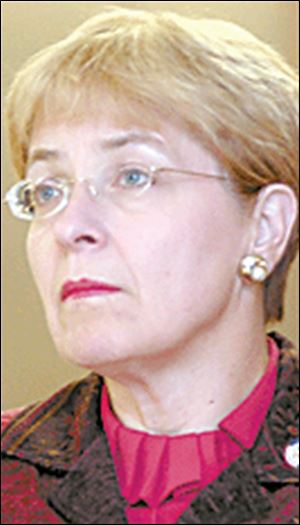
Kaptur asks U.S. to join bridge probe
3/2/2005
Kaptur
Saying she has deep concerns about a deadly crane collapse on the I-280 bridge project, U.S. Rep. Marcy Kaptur yesterday asked federal regulators to help in an unprecedented criminal investigation into the 2004 collapse that killed four workers.
In letters yesterday to the U.S. Department of Labor and U.S. Department of Transportation, Miss Kaptur (D., Toledo) asked both agencies to help Toledo police and the Lucas County prosecutor's office in their probe of one of the worst construction accidents in Toledo history.
It's part of a broader push by the veteran congressman to answer not only what went wrong on the job site, but also what went wrong with federal worker-safety oversight on Ohio's largest construction project.
"These deaths were preventable," Miss Kaptur told The Blade.
Her request was made two weeks after The Blade published an investigation of the collapse of the horizontal crane last year while it was being set up to build a future curve of the bridge's approach in East Toledo.
The U.S. Occupational Safety and Health Administration would later blame Fru-Con for not properly anchoring the crane and a twin also used on the site.
In reviewing thousands of records regarding the Feb. 16, 2004, collapse, The Blade found that:
●The project contractor, Fru-Con, used fewer anchors on the cranes, despite early warnings about unsafe anchoring from the cranes' manufacturer.
●Fru-Con kept using the cranes despite its own complaints about design flaws, including an inability to "accommodate" curves in the new bridge.
●Neither OSHA nor a state workplace inspector assessed the safety of the 2-million-pound cranes, despite requiring workers to attach their safety harnesses to them.
Saying she wrote to the agencies "with great sadness and a deep sense of responsibility," Miss Kaptur cited those findings in letters sent to OSHA's top administrator, Jonathan Snare, and the Inspector General of the U.S. Department of Transportation, Kenneth Mead. The federal transportation department is paying for nearly all of the $220 million project.
Following up on informal requests made in the past two months, Miss Kaptur formally asked the transportation department yesterday to enlist its investigators to help local authorities with a case that prosecutors have said could cost hundreds of thousands of dollars, if not millions, to properly investigate and prosecute.
John Weglian, chief of the prosecutor's special units division, said yesterday that the case involves understanding complex engineering concepts to prove what caused the collapse and prove, at the very least, criminal recklessness.
A homicide investigator has been assigned full-time to the case, and authorities have continued to comb through records of the collapse, Mr. Weglian said. But he said he would welcome any help from outside agencies.
Calling it an "exhaustive" investigation by local authorities, Miss Kaptur asked OSHA to join in helping the U.S. Department of Transportation's investigators with the case.
Representatives from OSHA and the U.S. transportation department did not respond to requests for comment.
Beyond asking for help with the investigation, Miss Kaptur also asked OSHA to give her details of current and proposed federal standards for assembling or operating construction cranes, including those that are built overseas and custom-built for one job.
The cranes used on the I-280 project were manufactured in Italy and designed for the I-280 project, and there is wide agreement in the industry that federal design standards are confusing and outdated. A special OSHA-led committee has proposed new rules, but critics say they still allow lower standards for foreign-built cranes, and there's still confusion about the standards for custom-built models.
In an interview with The Blade, Miss Kaptur also expressed concerns about an OSHA oversight process that didn't include any inspections of two pieces of high-profile equipment that were rare in America and had never before been used in Ohio.
"It appears as though crane inspection was not part of their mantra. It was not part of their responsibility," she said.
Miss Kaptur's concerns dovetail those of ironworkers like Roger Henneman, whose leg was broken during the collapse. He said he's frustrated at a system where workers can be fired if inspectors catch them not wearing safety glasses or harnesses, but there's lax standards on properly testing and inspecting the equipment to which they're required to attach their harnesses.
"Us workers, being on the bottom of the totem pole, we're not protected enough because everybody above us didn't get killed or injured. We did. We were pinned in a corner," said Mr. Henneman, who is still recovering from his injury.
In her letters, Miss Kaptur cited another finding by The Blade's investigation - that Fru-Con didn't share the concerns about anchoring or crane design flaws with workers. The sharing of safety concerns was called for in a special safety agreement Fru-Con signed with OSHA and the unions nearly a year before the collapse.
OSHA later pulled out of the agreement after proposing citations of $280,000, the maximum allowed by law, for four "willful" violations of safety rules requiring Fru-Con to follow the manufacturer's specifications on anchoring. Fru-Con has appealed the citations, and Fru-Con has claimed the Italian manufacturer approved the anchoring modifications, which the manufacturer has denied.
Miss Kaptur said regulators must study what failed on the job site as well as in the oversight process, and she said the government owes it to those who died to come up with ways to lessen the chances of similar accidents.
"We have to learn from this," she said.
Contact Joe Mahr at:
jmahr@theblade.com
or 419-724-6180.